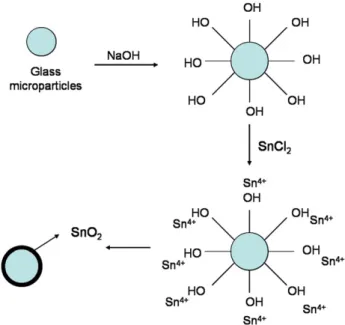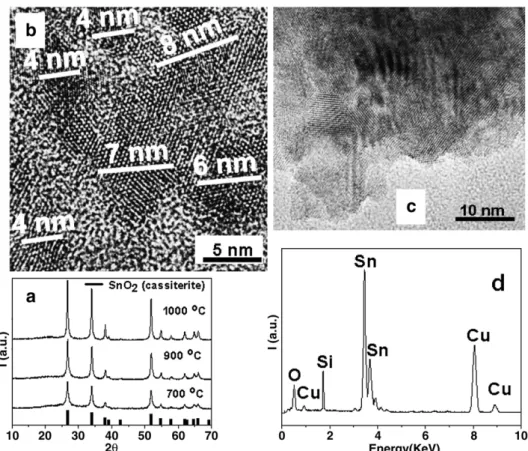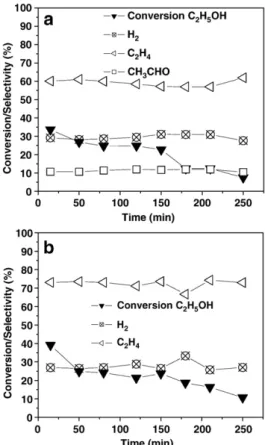SnO
2
nanoparticles functionalized in amorphous silica and glass
Neftali L.V. Carreño
a,⁎
, Michael R. Nunes
a, Cristiane W. Raubach
a, Rosana L. Granada
a, Matheus Z. Krolow
a,
Marcelo O. Orlandi
b, Humberto V. Fajardo
c, Luiz F.D. Probst
daInstituto de Química e Geociências, Universidade Federal de Pelotas, 96010-900, Pelotas, RS, Brazil bInstituto de Química, Universidade Estadual Paulista, 15385-000, Araraquara, SP, Brazil cDepartamento de Química, Universidade Federal de Ouro Preto, 35400-000, Ouro Preto, MG, Brazil dDepartamento de Química, Universidade Federal de Santa Catarina, 88040-900, Florianópolis, SC, Brazil
a b s t r a c t
a r t i c l e
i n f o
Article history: Received 10 March 2008
Received in revised form 21 February 2009 Accepted 29 May 2009
Available online 9 June 2009
Keywords: Nanomaterials
Polymeric precursor method Amorphous material
Two different routes to obtain SnO2nanoparticles, undoped and doped with rare earth metals (Eu or Pr), are
described herein. Thefirst route was based on the polymeric precursor method that led to the obtainment of SnO2nanoparticles dispersed in amorphous silica. The second route was simply the impregnation with SnCl4
aqueous solution of SiO2–CaO glass microparticles functionalized with hydroxyl (−OH) groups. The materials
were characterized by N2physisorption, XRD, EDS and TEM analyses. We also present the results of catalytic
experiments involving the nanocrystalline composites in ethanol steam reforming. The catalytic properties of the undoped composites with SnO2supported on SiO2–CaO glass differ from their doped analogues, however,
they were both selective towards ethylene formation, in contrast to the doped composite obtained by the polymeric precursor method.
© 2009 Elsevier B.V. All rights reserved.
1. Introduction
Several technological and scientific phenomena in materials science are directly related to particle size. In some cases, such as for catalysts, it is desirable to produce materials with nanometer-scale structures to obtain specific properties. A recent method to obtain several stable metal nanoparticles is based on the use of an amorphous matrix and the functionalizing of nanoparticles in different solid supports[1–3].
In this study SnO2 particles chemically functionalized in
silica-derived material and chemically modified glass (based on SiO2–CaO)
were synthesized and chemically modified by rare earth metal doping. Different routes of synthesis and dopants were used in order to compare the structural characteristics and catalytic performance of analogous materials. We also present the preliminary results of their application in the catalytic steam reforming of ethanol. Tin oxide nanoparticles have been previously investigated in our laboratory. This oxide has been used in a large range of technological applications, including sensors and catalysts. We recently showed that the modification of the nanometric-scale structure and the composition of particles can lead to interesting selectivity changes for the methanol decomposition and aldolization reaction between acetone and methanol[3,4].
2. Experimental
2.1. SnO2nanoparticles synthesized by polymeric precursor route
The chemical process used for the preparation of the SnO2–SiO2
doped and undoped nanoparticles, seeFig. 1, consisted of the initial formation of a metal-citrate by mixing citric acid (CA) (Aldrich)[3,5], the metal precursor SnCl22H2O (Aldrich), a tetramethyl orthosilicate
(Merck) solution and as the dopant a 5 mol% aqueous solution of Eu2O3(Aldrich) in relation to Sn. The CA:metal mol ratio was 3:1 in
water. The subsequent step is polymerization, by the addition of ethylene glycol (EG). These mixtures were homogenized for 15 min at room temperature and the polymerization was initialized by adding EG in a mass ratio of 40:60 in relation to the citric acid. Thefinal SnO2
nanocomposites were obtained by a two-step pyrolysis of the polymeric intermediate at 250 °C for 2 h, and a second heat treatment at temperatures higher than 500 °C performed in an air atmosphere.
2.2. Synthesis of SnO2nanoparticles by milling SiO2–CaO functionalized glass
Initially, common glass sheets (Pro-Cito) consisting mainly of SiO2
(50–60%) and CaO (27–35%) were milled in a Quimis ball mill for a period of 20 h. The milled material was sieved and only the particles smaller than 300 μm were used for the synthesis. The next stage consisted of pre-washing the glass microparticles with water and isopropyl alcohol (Synth), followed by a treatment with 0.25 mol L−1
NaOH using ultra-sound for 12 h. The aim of this treatment was to ⁎Corresponding author. Universidade Federal de Pelotas, Instituto de Química e
Geociências, Departamento de Química Analítica e Inorgânica, Caixa Postal 354, CEP-96010-900, Pelotas, RS, Brazil. Tel./fax: +55 53 3275 7354.
E-mail address:neftali@ufpel.edu.br(N.L.V. Carreño).
create functional−OH groups on the glass surface since reports in the
literature[6,7]suggest that Sn4+ions (in solution) are adsorbed on
the modified glass surface. The material was then dried for later addition of a 0.1 mol L−1aqueous solution of SnCl
45H2O. In order to
obtain the doped nanoparticles, 1 mass% of Pr (praseodymium nitrate, Aldrich) was used in relation to the mass of Sn. Finally, the samples were dried at 200 °C for 3 h and calcined in air at temperatures higher than 500 °C for 2 h. A diagrammatic representation of the procedure used in the synthesis is given inFig. 2.
2.3. Characterization
The structural analysis of SnO2nanoparticles was carried out by
X-ray diffraction (XRD; Siemens, model D-5000). The structure and morphology of the samples were studied by transmission electron microscopy (TEM; Jeol, model 3010, operated at 300 kV) equipped with X-ray energy dispersive spectroscopy (EDS). In order to analyze samples by electron microscopy, a dispersion of the material was carried out in an alcohol medium and a few drops were dropped onto carbon-coated Cu grids. The specific surface area of the nanocompo-sites was determined using an Autosorb-1C analyzer (Quantachrome
Instruments). The chemical concentration of all tin samples, after heat treatment, was determined by Energy Dispersive X-ray Fluorescence Spectrometer (Shimadzu EDX 720).
Catalytic performance tests were conducted at atmospheric pressure with a quartzfixed-bed reactorfitted into a programmable oven, at a temperature of 500 °C. The water:ethanol mixture (molar ratio 3:1) was pumped into a heated chamber, with a temperature of approximately 200 °C, and vaporized. The water–ethanol gas (N2)
stream (30 mL/min) was then fed to the reactor containing 100 mg of the catalyst. The experiments were performed under diluted condi-tions (80% N2). The reactants and the composition of the reactor
effluent were analyzed with a gas chromatograph (Shimadzu GC 8A), equipped with a thermal conductivity detector, a Porapak-Q and 5A molecular sieve columns with Ar as the carrier gas. Reaction data were recorded for 4 h.
3. Results and discussion
3.1. SnO2nanoparticles synthesized by polymeric precursor route
Fig. 3a illustrates the typical XRD patterns of Eu-doped SnO2/SiO2
samples, at different heat-treatment temperatures. In these patterns the peaks can be ascribed to the tetragonal cassiterite phase of crystalline SnO2 [3]. No diffraction peaks related to the secondary
phase of silica and Eu were observed in the doped sample. A similar behavior was also observed for the undoped samples (not shown). This suggests that the SnO2 nanoparticles are dispersed in the
amorphous silica.Fig. 3b and c shows the high resolution transmission electron microscopy (HRTEM) images of Eu-doped SnO2/SiO2,
annealed at 900 and 1000 °C, respectively, which show in some regions of the material a mean particle size of less than 9 nm.Fig. 3b clearly shows several amorphous regions of silica between the SnO2
nanocrystalline particles. It is believed that these amorphous regions have an important role in the control of the particle size of SnO2
nanostructures[6,7], and thus, apparently, the coalescent effect is decreased. Additional analysis by EDS coupled to TEM was carried out to probe the composition of the SnO2material functionalized with Si,
as shown inFig. 3d. The peaks of Sn, O and Si were clearly observed. In this analysis Eu was not detected, since the concentration of this component in the sample is too low. However, thefinal Eu, Si and Sn contents in the Eu-doped SnO2/SiO2 samples were 0.7, 22.0 and
77.3 wt.%, respectively, as determined by Energy Dispersive X-ray Fluorescence Spectrometer.
Leite et al.[8]suggested that rare earth dopants can be used to control particle size and protect SnO2against particle growth at high
temperatures. The formation of a second phase, composed of the dopant element, which is segregated at the particle surface (meta-stable solid solution), may be monitored by XRD with the appearance
Fig. 1.Reaction of the formation of the polymeric precursor using Sn4+ions.
of additional peaks (relating to the dopants) on the diffractogram with the increase in the treatment temperature of the material. This is consistent withfindings reported in the literature[3,8]. However, the diffractogram peaks related to the SnO2 phase did not show the
formation of a solid solution, even for the sample heat-treated at 1000 °C. This suggests that the SnO2particles are strongly influenced
by the presence of silica in the nanostructured system.
3.2. SnO2nanoparticles synthesized by milling SiO2–CaO functionalized glass
Fig. 4a shows the XRD peaks of the crystalline phase as a function of the heat treatment of SnO2 powders functionalized with
micro-metric particles of SiO2–CaO glass. InFig. 4a it can be observed that
there is a slight narrowing of the diffraction peaks as a function of the increase in calcination temperature, which is related to the crystalline cassiterite phase of SnO2. The XRD of the doped sample with 1 mass%
of praseodymium showed no significant change as a consequence of the addition of dopant to the ceramic matrix.
Through an analysis of the SnO2/SiO2–CaO sample calcined at
700 °C, using the TEM technique, it was observed that the material used as a support had micrometric-sized particles. The TEM analysis of the edges of this material, as shown inFig. 4b, had regions with a sufficientlyfine thickness to allow a more detailed analysis of the surfaces, as well as the interaction of the glass particles with the SnO2.
Fig. 4c, obtained by HRTEM, clearly shows that one of these regions contains several SnO2nanoparticles with a narrow size range of 2–
6 nm (diameter). This result verifies the efficiency of the chemical method employed in the functionalization of SnO2 over the glass
support. Additional analysis of these samples using TEM images of
other regions, shown in Fig. 4d, reveals the presence of several nanoparticles, which are detailed in the HRTEM images inFig. 4e (in dark circles). Reports in the literature[6,7]suggest that Sn4+ions (in
solution) are adsorbed on the modified glass, through electrostatic interactions of electronegative groups (−OH) obtained in the
activa-tion of its surface, as can be observed inFig. 2.
The final Si and Sn contents in the undoped SnO2/SiO2–CaO
samples were 44 and 31 wt.%, respectively, determined by Energy Dispersive X-ray Fluorescence Spectrometer. Thefinal Pr content of the dopants cannot be estimated through the technique used.
3.3. Catalytic applications
In order to investigate the catalytic activity of the samples, the steam reforming of ethanol was carried out. The catalytic behaviors of the different samples (SnO2/SiO2–CaO and Pr-doped SnO2/SiO2–
CaO) were studied and compared (Fig. 5a and b, respectively). The catalytic behavior of the SnO2/SiO2sample doped with Eu was also
investigated (Fig. 6). The SnO2/SiO2–CaO and Pr-doped SnO2/SiO2–
CaO catalysts showed similar activity in terms of ethanol conversion. In spite of the low specific surface areas (3 m2/g for SnO
2/SiO2–CaO
and 2 m2/g for Pr-doped SnO
2/SiO2–CaO), the catalysts achieved
reasonable ethanol conversion values at the beginning of the test, (around 40%). However, it is interesting to observe that the catalysts presented a distinct behavior in terms of product selectivities. From the results ofFig. 5, it can be seen that H2, C2H4
and CH3CHO were the products detected in the reaction effluent of
the ethanol steam reforming process using the SnO2/SiO2–CaO
catalyst. Ethylene was the major product formed, with lower amounts of hydrogen and acetaldehyde, indicating that ethanol
dehydration and dehydrogenation reactions (Eqs. (1) and (2), respectively) are promoted over the catalyst surface.
C
2H5OH→C2H4þH2O ð1Þ
C2H5OH→CH3CHOþH2 ð2Þ
On the other hand, H2and C2H4were the only products formed
during the ethanol steam reforming process over Pr-doped SnO2/
SiO2–CaO catalyst, indicating that ethanol dehydrogenation to
acetaldehyde (Eq.(2)) is negligible. Instead, ethanol dehydration to ethylene (Eq. (1)) and an ethanol decomposition reaction (Eq. (3)) seem to occur as the main reactions.
C2H5OH→2H2þ2CþH2O ð3Þ
The reaction pathway during catalytic ethanol steam reforming comprises a series of simultaneous reactions, including decomposi-tion, dehydrogenadecomposi-tion, dehydration and steam reforming reactions. These reactions are more or less promoted depending on the nature of the catalyst, the type of interaction with the surface of the solid material and the different reaction conditions[9,10].
Generally, according to the mechanism previously described for ethanol steam reforming, catalysts that have acidic characteristics, such as SiO2, are known to favor the dehydration reaction to ethylene
and water. In contrast, basic materials, such as La2O3, favor
dehydrogenation to acetaldehyde. According to the results, it can be seen that dehydration and dehydrogenation reactions are promoted over SnO2/SiO2–CaO catalyst. Thus, a combination of catalytic
properties can be observed on the surface of this catalyst, indicating that this particular catalyst has a great efficiency in the dehydration of ethanol and a mild capability for dehydrogenation of ethanol. The
From the results inFig. 6it can be seen that hydrogen, ethylene and acetaldehyde were the only products detected during the ethanol steam reforming process over the Eu-doped SnO2/SiO2 catalyst.
Acetaldehyde was the major product formed, with lower amounts of hydrogen and ethylene, and therefore, dehydration and dehydrogena-tion reacdehydrogena-tions are promoted over this catalyst.
4. Conclusions
The incorporation of stable SnO2nanoparticles into SiO2materials,
doped with rare earth metals and undoped, was achieved. The results indicated that the amorphous silica regions of the material have an important role in the control of SnO2particle size.
The physico-chemical changes obtained through the preparation of the material at different temperatures were evaluated and no notable alterations in the structural properties were observed. The catalytic activity of the materials was monitored. It could be observed that the addition of dopants led to changes in the catalytic behavior of the materials with regard to the reaction of ethanol steam reforming.
It was also found that the SnO2/SiO2–CaO and Pr-doped SnO2/
SiO2–CaO catalysts were very selective toward ethylene, which is very
well known as an important raw material in the polymeric industry.
Acknowledgment
This research was supported by the following Brazilian funding support agencies: CNPq, FINEP/CT-PETRO, FAPESP and FAPERGS. The TEM facilities were provided by the LME-LNLS (National Laboratory of Synchrotron Light), Campinas, Brazil.
References
[1] A.P. Alivisatos, Semiconductor clusters, nanocrystals, and quantum dots, Science 271 (5251) (1996) 933–937.
[2] A. De, S. Ray, A study of the structural and electronic-properties of magnetron sputtered tin oxide-films, Appl. Phys. 24 (5) (1991) 719–726.
[3] N.L.V. Carreño, A.P. Maciel, E.R. Leite, P.N. Lisboa-Filho, E. Longo, A. Valentini, L.F.D. Probst, C.O. Paiva-Santos, W.H. Schreiner, The influence of cation segregation on the methanol decomposition on nanostructured SnO2, Sens. Actuators B 86 (2–3) (2002) 185–192.
[4] N.L.V. Carreño, H.V. Fajardo, A.P. Maciel, A. Valentini, F.M. Pontes, L.F.D. Probst, E.R. Leite, E. Longo, Selective synthesis of vinyl ketone over SnO2nanoparticle catalysts doped with rare earths, J. Mol. Catal. A 207 (2004) 89–94.
[5] E.R. Leite, N.L.V. Carreño, E. Longo, F.M. Pontes, A. Barison, A.G. Ferreira, Y. Maniette, J.A. Varela, Development of metal–SiO2nanocomposites in a single-step process by the polymerizable complex method, Chem. Mater. 14 (9) (2002) 3722–3729.
[6] J. Xu, H.B. Yang, Q.J. Yu, L.X. Chang, X.F. Pang, X. Li, H.Y. Zhu, M.H. Li, G.T. Zou, Synthesis and characterization of hollow glass microspheres coated by SnO2 nanoparticles, Mater. Lett. 61 (6) (2007) 1424–1428.
[7] F. Du, Z. Guo, G. Li, Hydrothermal synthesis of SnO2hollow microspheres, Mater. Lett. 59 (19–20) (2005) 2563–2565.
[8] E.R. Leite, A.P. Maciel, I.T. Weber, P.N. Lisboa-Filho, E. Longo, C.O. Paiva-Santos, C.A. Pakoscimas, Y. Maniette, W.H. Schreiner, Development of metal oxide nanopar-ticles with high stability against particle growth using a metastable solid solution, Adv. Mater. 14 (12) (2002) 905–908.
[9] S. Haryanto, N. Fernando, N. Murali, S. Adhikari, Current status of hydrogen production techniques by steam reforming of ethanol: a review, Energy Fuels 19 (5) (2005) 2098–2106.
[10] P.D. Vaidya, A.E. Rodrigues, Insight into steam reforming of ethanol to produce hydrogen for fuel cells, Chem. Eng. J. 117 (1) (2006) 39–49.
[11] X. Li, B. Shen, Q. Guo, J. Gao, Effects of large pore zeolite additions in the catalytic pyrolysis catalyst on the light olefins production, Catal. Today 125 (3–4) (2007) 270–277.
Fig. 5.Catalytic performance in the steam reforming of ethanol over a) undoped and b) Pr-doped SnO2/SiO2–CaO glass samples annealed at 700 °C, with a H2O/C2H5OH molar ratio of 3, at 500 °C.


